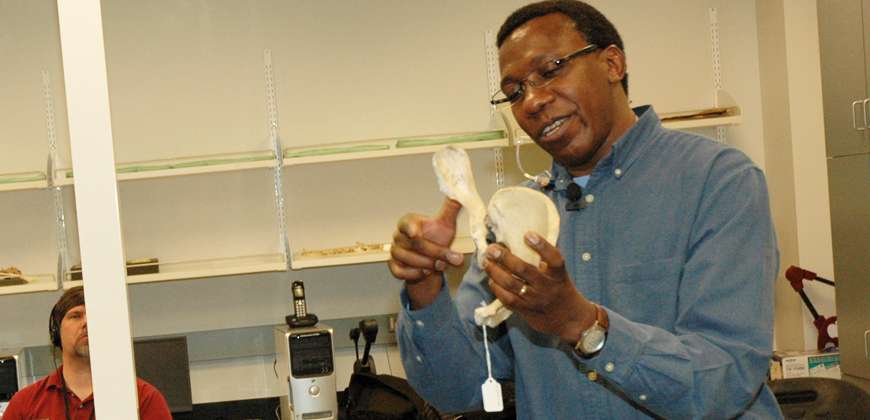CU Denver’s Musiba to join Rising Star expedition

CU Denver
A trove of ancient bones is about as irresistible as it gets for an anthropologist, especially one whose life's study has centered on human origins.
That's why Charles Musiba, PhD, enthusiastically responded to the call to join an elite group of paleoanthropologists in South Africa to catalogue and systematically analyze some 2,000 bone fragments found deep in a cave. The Rising Star Expedition, led by Professor Lee Berger of the University of the Witwatersrand of Johannesburg, was assembled last fall, with 35 scientists all working for the first time together in the field.
"They discovered the cave and started excavating it last November, and realized they had so many bones they couldn't finish working on it by themselves," Musiba said of Berger's team. "So they invited a group of scientists to come help. I got to go because of my experience working on paleoanthropological sites in East Africa."
Musiba, a native of Tanzania and associate professor in CU Denver's Anthropology Department in the College of Liberal Arts and Sciences, has spent decades hunting for fossils that date back millions of years. The focus of his study are the famed Olduvai Gorge and Laetoli fossil sitesin northern Tanzania. The sites are where the earliest hominids left traces of man's first forays upon two legs.
The Rising Star Expedition, sponsored by National Geographic, required cavers of slim builds—women mostly—who could shimmy through small openings to various chambers some 30 meters underground. Once the bones were recovered, they were brought to the surface where scientists, including Musiba, studied them. He is an expert in taphonomy and paleoecology—the study of environmental conditions affecting the preservation of animal and plant remains.
"The question is: Where in the link of the evolutionary tree do these remains fit?" Musiba said. He can't discuss the discovery in detail yet—the scientists have submitted their findings to a major science journal—but he did say the bones are from hominids and the evolutionary implication appears to be "huge."
"That trip was the tip of the iceberg," said Musiba, who was offered an honorary associate professorship with the University of Witwatersrand in Johannesburg. "I'm planning to go back to South Africa in November to continue with the work."
Among the questions the international team is considering is whether the cave could have been used as a prehistoric burial site. The number of researchers who co-authored sections of the study ranged from 15 to 30. Musiba is a co-investigator on three sections of the study: geology, skull descriptions and context, as in how the discoveries were made and in what condition the bones were found.
"It's exciting. It's about us. It's about who we are," he said. "As humans, we're so diverse, but genetically we're so homogenous. We're the only species that is so homogeneous genetically."
Each time he goes into the field the excitement rises. So when Musiba was summoned to this expedition, a star-studded group of scientists who are at the top of their fields, he couldn't help but feel he was embarking on a career highlight. The excitement only grew when the bones were recovered, and then long hours were spent in South African natural science museums comparing the fragments to previously found bones.
"It's almost like a puzzle sometimes," Musiba said. "You're looking at one fragment out of 2,000 bone fragments. You're looking at one and seeing how it fits with other bones."
He said Berger's team has only been halfway into the cave, so much more remains to be discovered.
"It's exciting for me to investigate who our ancestors are," Musiba said. "For me, every time I get to go into the field it's an exciting time. Because you don't know what you're going to find. It's like opening the door to a candy store and not knowing what kind of candy you're going to end up with."
(Photos: Anthropology Associate Professor Charles Musiba, PhD, far left, and colleagues spent countless hours cataloguing and systematically analyzing bone fragments found in a South African cave. In these photos they work in a South African museum. Photos by Myra F. Laird and Jill E. Scott.)
###
Contact: christopher.casey@ucdenver.edu




